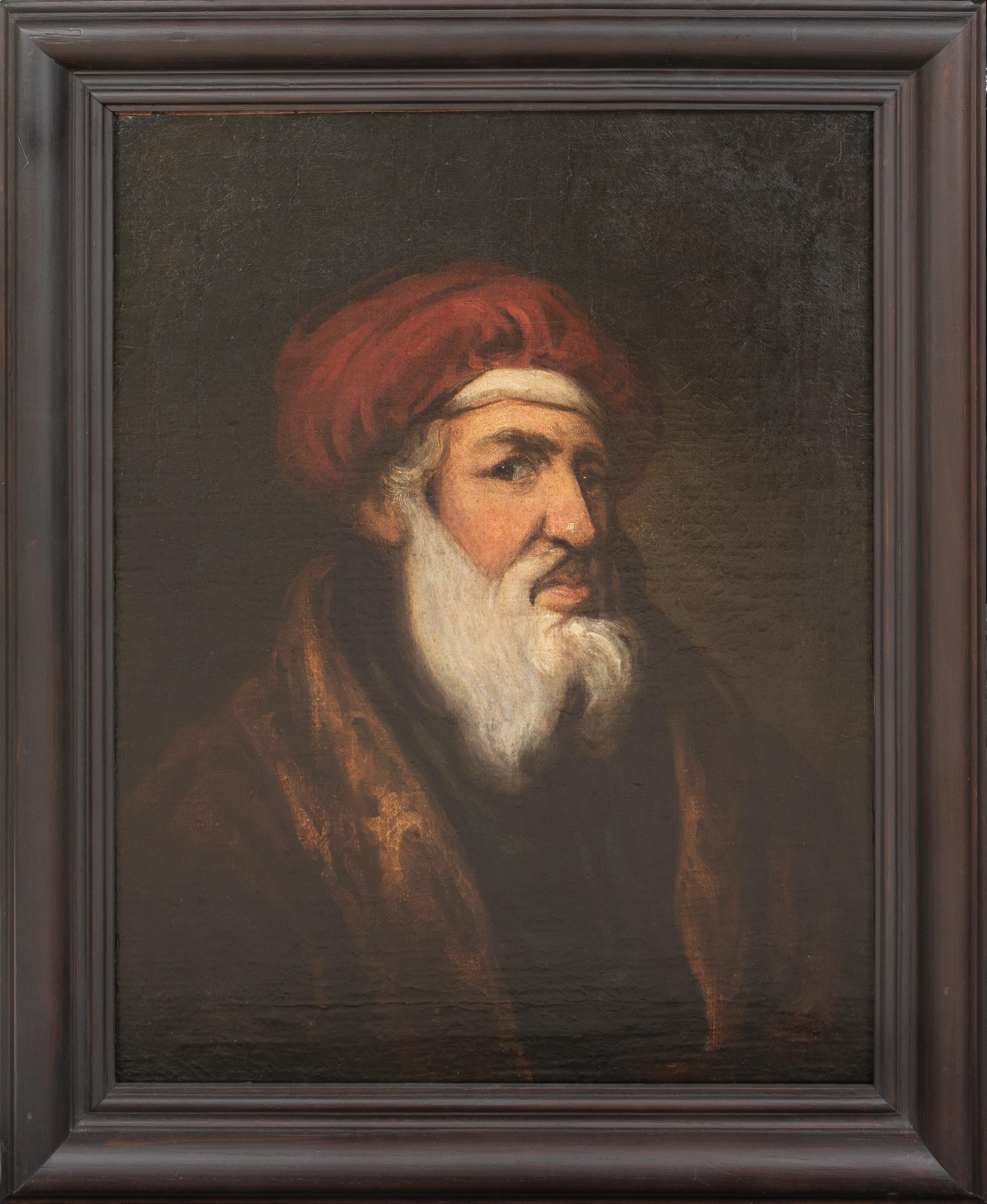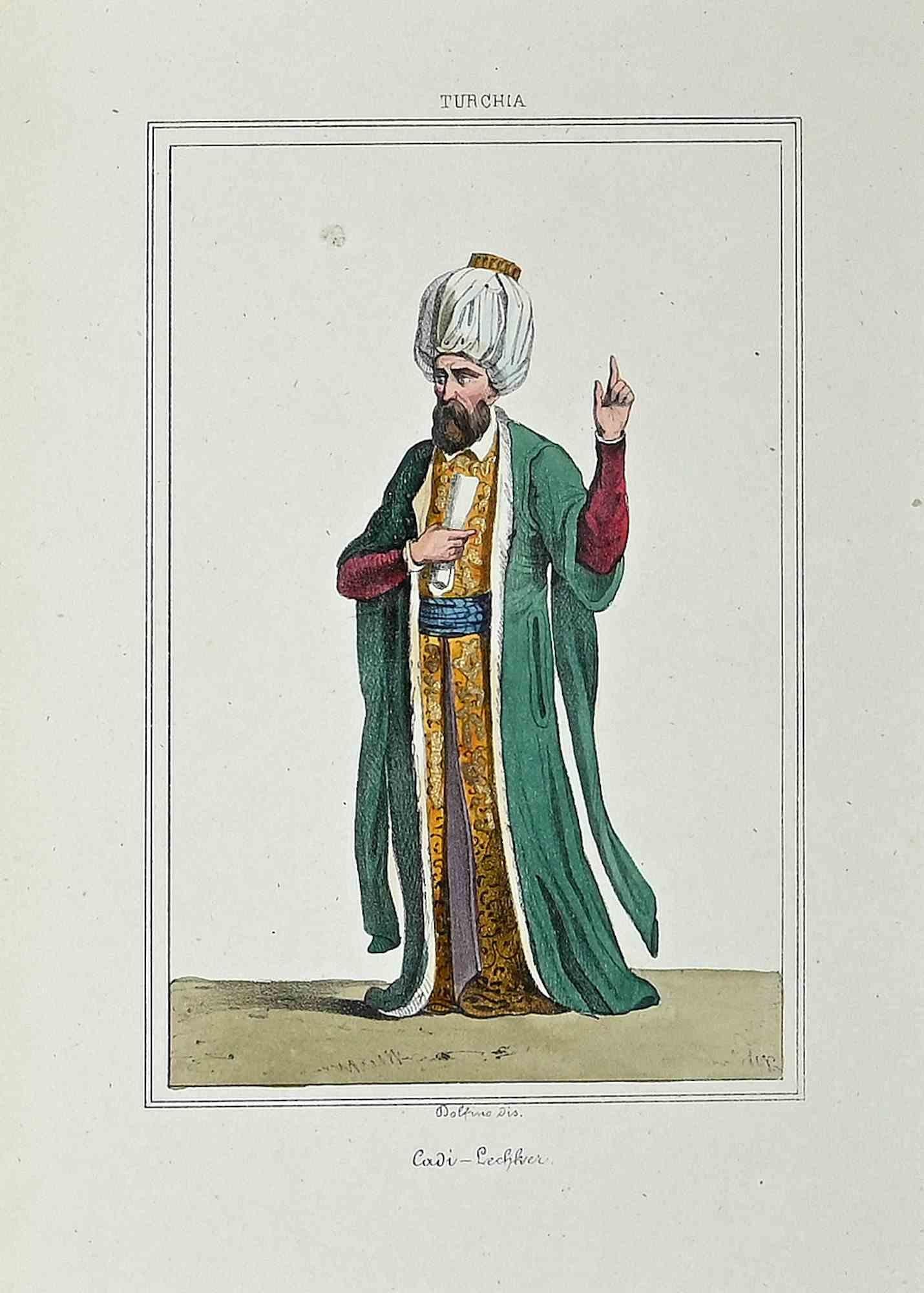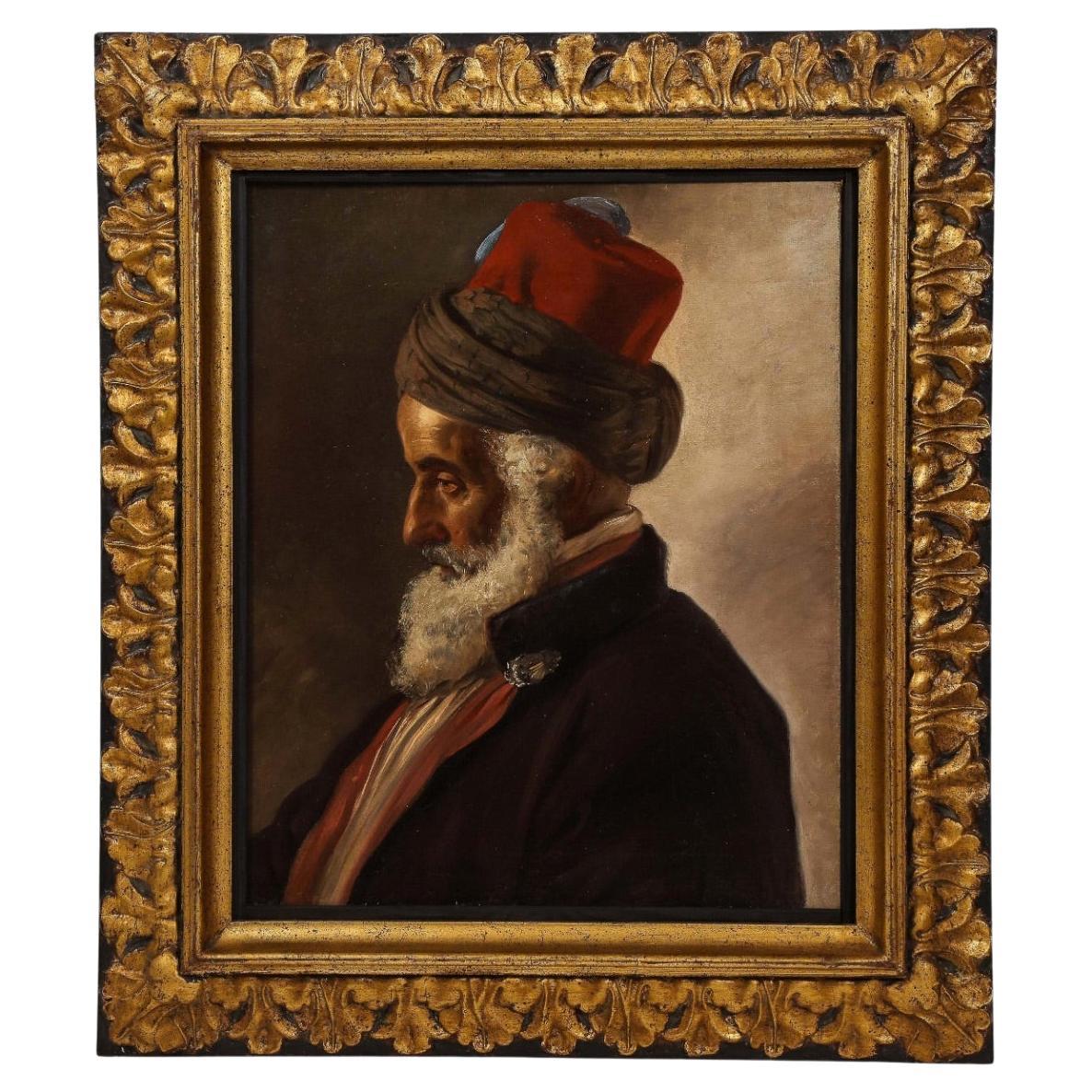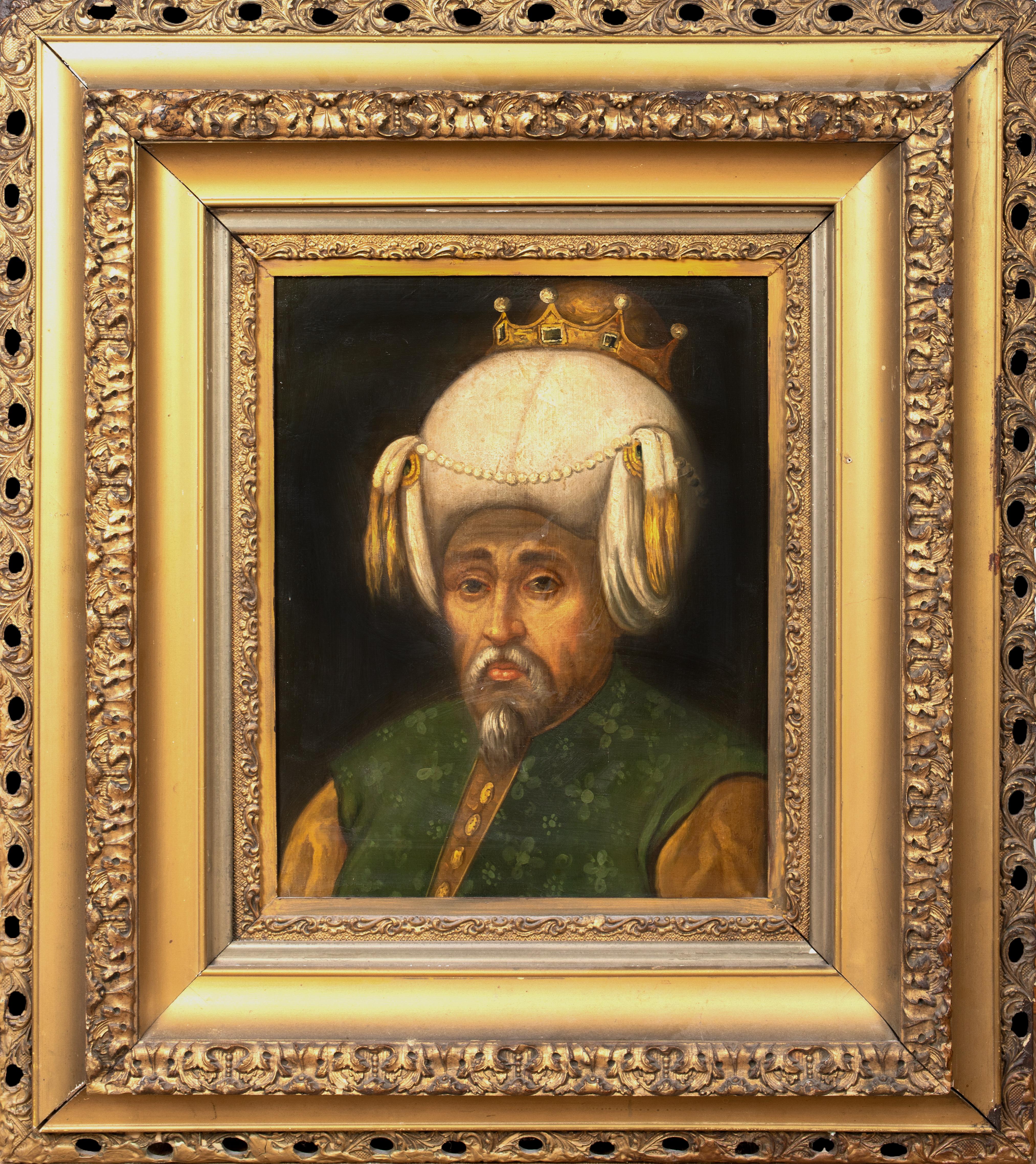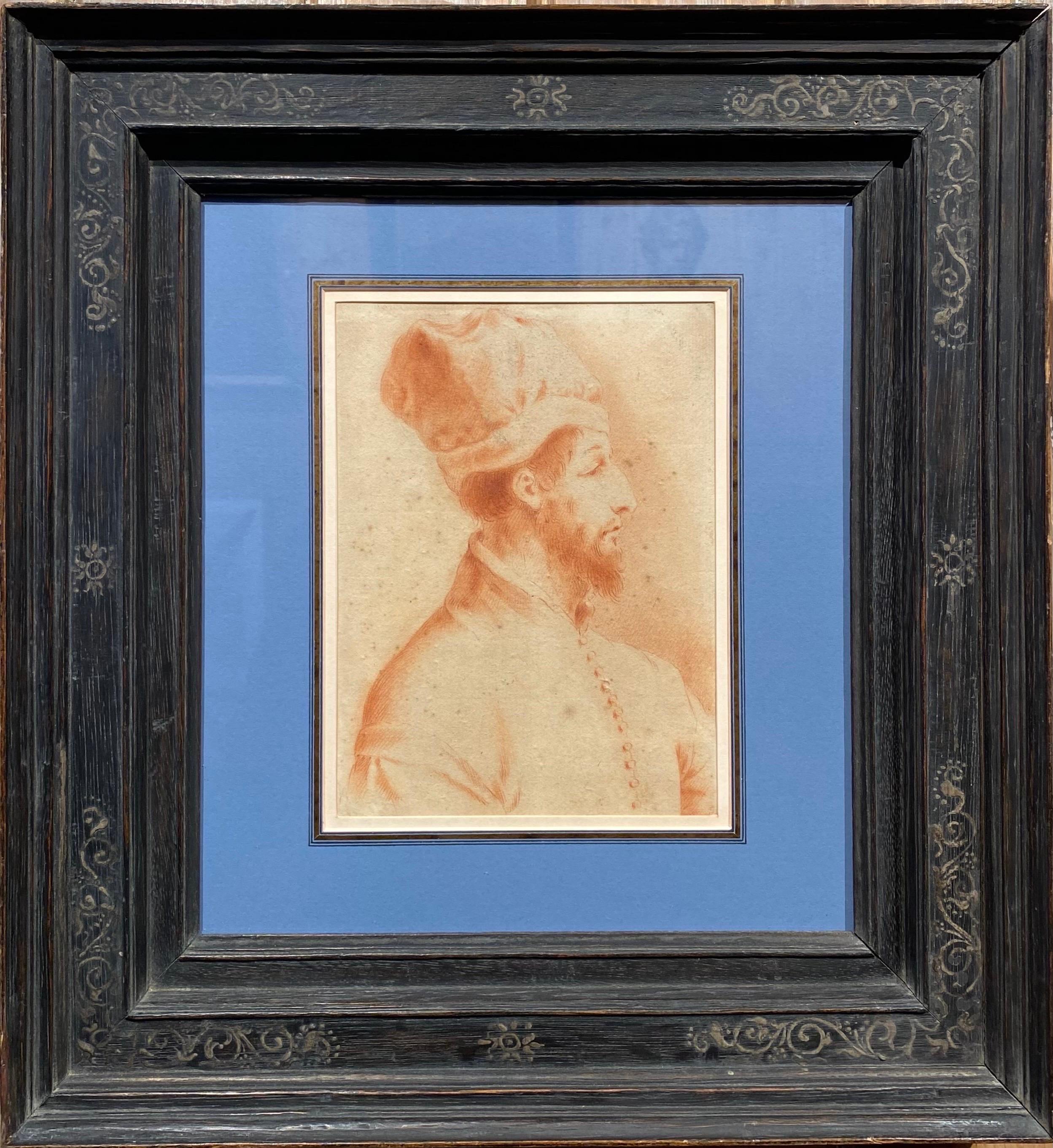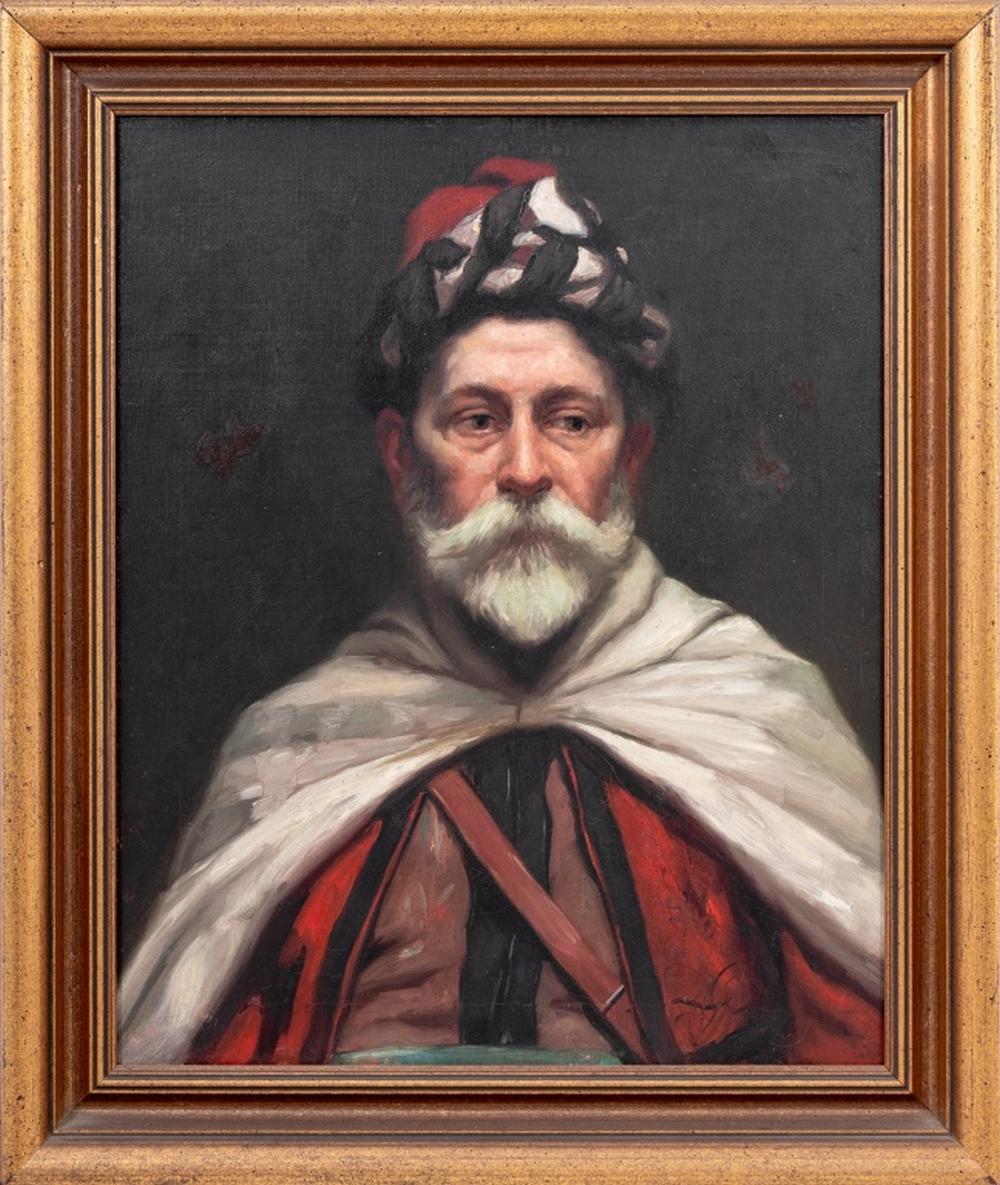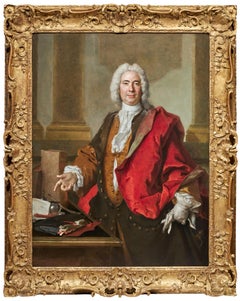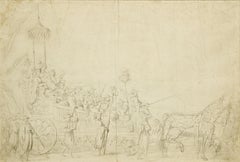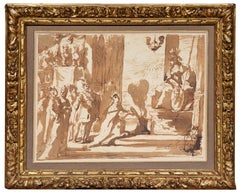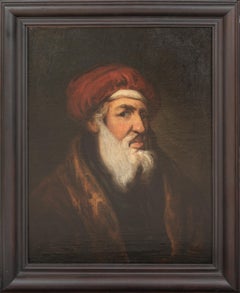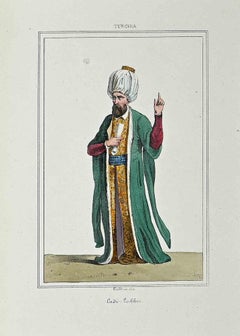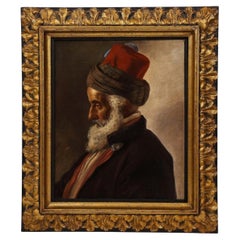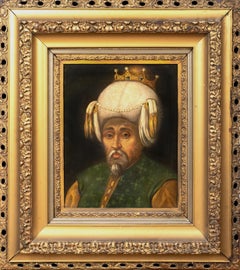Items Similar to Portrait of an Ottoman Dignitary, a drawing by Giuseppe Nogari (ca. 1760)
Want more images or videos?
Request additional images or videos from the seller
1 of 13
Giuseppe Nogari Portrait of an Ottoman Dignitary, a drawing by Giuseppe Nogari (ca. 1760)ca. 1760
ca. 1760
$14,777.25
£11,125.77
€12,500
CA$20,394.82
A$22,846.70
CHF 11,883.12
MX$278,682.61
NOK 151,287.97
SEK 142,653.77
DKK 95,162.51
About the Item
We would like to thank Mrs. Bozena Anna Kowalczyk for confirming the attribution of this drawing to Giuseppe Nogari in a study (available in Italian) from which we have taken our inspiration for the presentation below.
A middle-aged man in a turban poses calmly before the artist. His magnetic, dreamy gaze is that of a sage. The use of black and white chalks delicately modulates his face on the perfectly preserved blue paper, revealing noble, delicate features: softly pursed lips, high cheekbones and fluffy white beard. The artist carefully describes the refinement of the turban, suggesting its precious, light muslin-like material, and lingers on the details of the oriental costume.
The great descriptive qualities, the softness of the modeling and the finesse of the psychological analysis lead us to Giuseppe Nogari, a Venetian painter sought after by the collectors of his time and highly esteemed by contemporary biographers for his heads of character.
1. Giuseppe Nogari, "a good colorist and excellent portraitist"
Pietro Guarienti, a Veronese painter and inspector of the Royal Gallery in Dresden, begins his lengthy note on the artist as follows: "Gioseffo Nogari, a famous Venetian painter, was at the school of Antonio Balestra, where, as long as he was there, he never gave any sign of that unique, tender, mellow and natural style, which he later developed". He then mentions the most important events of his career, starting with his meeting with Marquis Ottaviano Casnedi, who "having observed in Nogari a certain spirit and grace in the realization of half-figures, commissioned some from him.... and gave him some useful warnings, from which he profited so much, that in a short time, with his new singular manner, he rose to a distinguished reputation".
This meeting and the stay in Milan, described by Alessandro Longhi in his Compendium of 1762 , must predate by a few years the year 1736, when Count Carl Gustaf Tessin (1695-1770) succeeded in obtaining four paintings by Nogari in Venice: an Old Man with a Book, an Old Woman with a Spindle, a Young Girl with Turnips and a Young Girl in a brown Dress, judging the artist, already established in this genre of painting, as "admirable, exact, diligent, imitating nature like a Flemish artist" . These paintings, destined for the Royal Palace in Stockholm, are now in the National Museum.
Guarienti also recalls Nogari's stay at the court of Turin, where the painter worked from 1740 to 1742, and the commission by Joseph Smith (c. 1674 -1770), consul to His Britannic Majesty, of "various half-figures of excellent taste, naturally expressed and gracefully colored"; he also mentions Augustus III, King of Poland and Elector of Saxony, as one of his collectors, to whom Francesco Algarotti procured four of Nogari's canvases in 1743, now in the Gemäldegalerie in Dresden. In his famous letter dated February 13, 1751, addressed from Potsdam to Pierre-Jean Mariette in Paris, the Venetian intellectual describes his purchase as follows: "two half-figures in a very soft manner, lost in the contours, and all worked with halftones by Signor Giuseppe Nogari, a naturalist painter, who is inspired above all other schools by that of Flanders" .
Mariette, for his part, stresses the importance of Marquis Casnedi's advice to abandon history painting, and "as he had a pleasant brush, he pleased and made himself a reputation that gave him a number of supporters" .
The artist devoted himself to portraits at various stages of his career. The first documented portrait is the Equestrian Portrait of Field Marshal Johann Matthias von der Schulenburg, executed in collaboration with Francesco Simonini, recorded on May 5, 1737 in the inventories of German soldiers in the service of the Serenissima, now in a private collection . An engraving by Giovanni Cattini bears witness to the fine half-length Portrait of Francesco Zuccarelli, a Tuscan painter, probably from the 1740s . The two traditional full-length portraits of Giambattista Leoni and Doge Marco Foscarini, mentioned by the Venetian aristocrat Pietro Gradenigo in his Notatori on August 31, 1762, have now disappeared .
2. The Ottoman presence in Venice
From the fall of Constantinople in 1453 until the end of the Republic, Venice maintained diplomatic contacts with the Ottoman Empire. These were entrusted to a bailo, a special envoy chosen among the Venetian patricians.
In Venice, from the early 17th century, a Venetian palace on the Grand Canal was intended by the Serenissima to serve as a warehouse for the Ottomans, a function it retained until the 19th century.
Orientals populated the imagination of 18th-century Venetian artists, stimulated by the prints of Rembrandt and Giovanni Benedetto Castiglione. First of all, the two Tiepolos tirelessly came up with various types and costumes with which to animate historical and mythological scenes, specializing in the invention of turbaned male heads, both in painting and engraving. In 1740-1746, Giovanni Battista painted two full-length Ottomans for the Palazzo Cornaro in Campo San Polo, with turbans and costumes similar to those in this drawing (NG 6305 The National Gallery, London - 6th image in the gallery).
A number of oriental figures can also be found in Nogari paintings, such as the one of a turbaned geographer, formerly in the Christian Ludwig von Hagedorn collection, known from the mezzotint print by Johann Jakob Haid (1885,1212.13 - British Museum, London - 7th image in gallery). In contrast to this allegorical figure, the drawing we propose is a portrait of an Ottoman dignitary, probably executed in Venice since Nogari never visited Turkey, and not a fantasy figure like those imagined by the Tiepolos.
3. Comparable artworks
Very few drawings have yet been attributed to Giuseppe Nogari. Most of his drawings may have disappeared due to the conservation difficulties of the technique used, characterized by a fragile surface layer, as illustrated by the condition of the Elderly Woman with a striped Shawl in Venice's Museo Correr (8th image in the gallery). Also executed on blue paper - a medium commonly used in Venetian circles, from Tiepolo to Jacopo Amigoni - this drawing comes from the collection of Alessandro Longhi, a pupil of the artist. The charcoal and colored chalks are softly shaded, but the support has almost completely lost its original coloring and tends towards gray, which detracts from the naturalistic rendering the artist sought for this type of preparatory study. The stern gaze is turned towards the viewer, and the description insists on rendering the hollow cheeks and wrinkles around the mouth.
The pastel in the National Gallery of Art, Washington (1984.69.1 - last image in the gallery), depicts another expressive Elderly Woman with a striped Shawl, "a specific person recognizable from other works" . Giuseppe Nogari, who also practiced this technique , compares himself here to Rosalba Carriera by depicting a face marked by old age with extreme realism, achieving a realistic effect of great elegance in the rendering of the various materials: the flamboyant silk shawl, the soft fur trim, the rough brown fabric of the dress. In the magnetic gaze she addresses us, we find that of our Ottoman dignitary, the result of the same quest to translate the model's expressiveness through meticulous examination of detail.
4. Framing
Our drawing is presented in a large 18th-century Italian gilded and carved wood frame, which accentuates the majesty of this portrait.
- Creator:Giuseppe Nogari (1699 - 1763, Italian)
- Creation Year:ca. 1760
- Dimensions:Height: 21.63 in (54.95 cm)Width: 17.38 in (44.15 cm)
- Medium:
- Movement & Style:
- Period:1760-1769
- Condition:Black and white chalks on blue paper Dimensions: 11 7/8 X 9 3/8 in. (301 x 238 mm) - Framed: 21 5/8 x 17 3/8 in. (55 x 44 cm) Carved and gilded wood frame - 18th century Italy Unidentified collector's mark lower left.
- Gallery Location:PARIS, FR
- Reference Number:1stDibs: LU1568216498622
About the Seller
5.0
Vetted Professional Seller
Every seller passes strict standards for authenticity and reliability
Established in 2020
1stDibs seller since 2021
10 sales on 1stDibs
Typical response time: 2 hours
- ShippingRetrieving quote...Shipping from: PARIS, France
- Return Policy
Authenticity Guarantee
In the unlikely event there’s an issue with an item’s authenticity, contact us within 1 year for a full refund. DetailsMoney-Back Guarantee
If your item is not as described, is damaged in transit, or does not arrive, contact us within 7 days for a full refund. Details24-Hour Cancellation
You have a 24-hour grace period in which to reconsider your purchase, with no questions asked.Vetted Professional Sellers
Our world-class sellers must adhere to strict standards for service and quality, maintaining the integrity of our listings.Price-Match Guarantee
If you find that a seller listed the same item for a lower price elsewhere, we’ll match it.Trusted Global Delivery
Our best-in-class carrier network provides specialized shipping options worldwide, including custom delivery.More From This Seller
View AllPortrait of Monsieur Aubert, a ceremonial portrait by Nicolas de Largillière
By Nicolas de Largillière
Located in PARIS, FR
Provenance :
Arnold S. Kirkeby (1901-1962)
Donated by Arnold S. Kirkeby to the Los Angeles County Museum of Art in 1955, where it remained until its sale at Sotheby's, New York on Ja...
Category
1720s Old Masters Portrait Paintings
Materials
Oil
Study for « The Chinese Masquerade » by Jean-Baptiste Pierre (1714 - 1789)
By Jean-Baptiste Pierre
Located in PARIS, FR
Arriving in Rome in June 1735 as a resident at the Royal Academy, Pierre was unable to attend the Winter Carnival festivities of 1735, which he nevertheless immortalised in an engrav...
Category
1730s Old Masters Figurative Drawings and Watercolors
Materials
Graphite
Allegory of the Treaty of Angoulême, a drawing attributed to Donato Mascagni
Located in PARIS, FR
We would like to thank Mrs. Ursula Verena Fischer Pace for suggesting the attribution to Donato Arsenio Mascagni.
We were immediately seduced by the rich tonalities of this allegory...
Category
1620s Old Masters Figurative Drawings and Watercolors
Materials
Ink
Portrait of Senator Bartolomeo Panciatichi by Santi di Tito (1574)
Located in PARIS, FR
This recently rediscovered portrait of Santi di Tito depicts a Florentine senator, with a letter in his hand indicating that the painting was executed in 1574 when the sitter was 66 years old. On the basis of these clues, it is tempting to view it as a portrait of Bartolomeo Panciatichi, who was painted some thirty years before by Bronzino (1503 - 1572). While the treatment of the hands recalls the Florentine tradition of Mannerist portraits, the comparison with Bronzino's portrait illustrates Santi di Tito's search for greater realism, despite the stereotyped composition.
1. Santi di Tito, Counter-Reformation painter and portraitist
Santi di Tito was the great painter of the Florentine Counter-Reformation. He proposed a new artistic language that broke away from Mannerism.
Little is known about his training in Florence (perhaps alongside Bronzino or Baccio Bandinelli), but this period of training enabled him to join the Company of Saint Luke, the guild of Florentine painters, in 1554. Between 1560 and 1564, Santi di Tito spent time in Rome, where he frequented the workshop of Taddeo Zuccari. This stay had a fundamental influence on his work, thanks to the discovery of the late work of Raphael, but also his encounters with the painters Francesco Salviati and Federico Barocci.
Around 1565, Santi di Tito returned to Florence, where he remained until the end of his life, dividing his talents between the creation of important religious paintings and countless portraits. He became one of the city's leading painters, distinguishing himself, in particular, in the creation of large religious compositions in which the spirit of the Counter-Reformation was reflected.
In 1568, Santi di Tito became a member of the Confraternity of Saint Thomas Aquinas...
Category
16th Century Old Masters Portrait Paintings
Materials
Poplar, Oil
Studies for the Judgment of Solomon, a double-sided drawing by Simone Cantarini
Located in PARIS, FR
In this double-sided red chalk study, Simone Cantarini offers us a double reflection on the theme of the Judgment of Solomon. This sheet reveals his precise style and his sense of de...
Category
1640s Old Masters Figurative Drawings and Watercolors
Materials
Chalk, Laid Paper
Study for a Frontispiece, a baroque drawing by Giovanni Antonio Pellegrini
By Giovanni Antonio Pellegrini
Located in PARIS, FR
This masterly frontispiece study, executed with a very sure hand, testifies to the survival of the great Baroque taste in 18th century Venice. It could be one of the very last works by Giovanni Antonio Pellegrini: the few lines that cross the papal arms evoke those of Benedict XIV, who became pope in 1740, one year before the artist's death.
1. Giovanni Antonio Pellegrini and the European influence of Venetian history painting in the 18th century
Giovanni Antonio Pellegrini was born in Venice in 1675 and trained in the studio of the Milanese painter Paolo Pagani (1655 - 1716). Pagani, who had been living in Venice since 1667, took him to Moravia and Vienna from 1690 to 1696. After a stay in Rome from 1699 to 1701, Pellegrini married Angiola Carriera in 1704, the sister of the great pastelist Rosalba Carriera.
From 1708 onwards, Pellegrini left Venice and began an extensive tour of Europe: he worked in England between 1708 and 1713, where he met great success, particularly at Kimbolton Castle and Castle Howard. He then worked in Germany and the Netherlands, then in Bohemia and Austria, before returning briefly to England in 1719. In 1720 he was in Paris where he decorated the ceilings of the Royal Bank for John Law...
Category
1740s Old Masters Figurative Drawings and Watercolors
Materials
Ink
You May Also Like
Portrait Of Identified as Topal Osman Pasha (1663–1733), 18th Century
Located in Blackwater, GB
Portrait Traditionally Identified as Topal Osman Pasha (1663–1733), 18th Century
Italian School
Large 19th Century Italian School Ottoman portrait identified as Total Osman Pasha, oil on canvas. Circa 1730 profile portrait of the Ottoman military...
Category
17th Century Portrait Paintings
Materials
Oil, Canvas
$3,082 Sale Price
35% Off
Portrait of Turkish Sultan Cadi-Lechker - Original Lithograph - Mid 19th Century
Located in Roma, IT
Portrait of Turkish Sultan Cadi-Lechker is an original Lithograph realized by an anonymous artist in the mid 19th Century.
Good conditions.
The artwo...
Category
Mid-19th Century Modern Figurative Prints
Materials
Lithograph
Austrian School, 19th Century, an Orientalist Portrait of a Turkish Sultan
Located in Long Island City, NY
Austrian School, 19th century, An Orientalist Portrait of a Turkish Sultan.
Oil on Canvas, a very high quality painting, realistically painted of a ...
Category
Antique 19th Century Paintings
Materials
Canvas
Portrait of Osman I (1254-1323), 17th Century follower of PAOLO VERONESE (
By Paolo Veronese
Located in Blackwater, GB
Portrait of Osman I (1254-1323), 17th Century
follower of PAOLO VERONESE (1528-1588)
Large 17th Century Italian School portrait of Osman I, oil on canvas. Excellent quality and con...
Category
19th Century Portrait Paintings
Materials
Canvas, Oil
$5,723 Sale Price
35% Off
Portrait of a Merchant
By Giovanni Francesco Barbieri (Il Guercino)
Located in London, GB
Giovanni Francesco Barbieri Guercino
Italian 1591-1666
Portrait of a Merchant
Sanguine on laid paper
Image size: 12 ¾ x 16 inches (32 x 40....
Category
17th Century Old Masters Portrait Drawings and Watercolors
Materials
Graphite
$19,508
French School Portrait of an Ottoman Oil on Canvas
Located in Astoria, NY
French School, Portrait of an Ottoman, Oil on Canvas, 19th century, unsigned, giltwood frame. Image: 24" H x 19.5" W; frame: 30" H x 24.25" W.
Category
19th Century French School Portrait Paintings
Materials
Canvas, Oil
More Ways To Browse
Masters Drawings Signed
Antique Drawing Book
Drawing Of Venice
Old Master Italian Drawings
Drawings Italian 18th Century
Old Master Drawings Framed
Portrait Of Soldier
Old Masters Venice
Antique Inventions
German Portraits 19th Century
Royal Presentation Frame
Jean Smith
Flemish Portrait Painting
Turkish Portrait
Antique Rose Drawing
Old Masters Paintings Of Venice
Portrait Of Noble
Ottoman Antique Art
